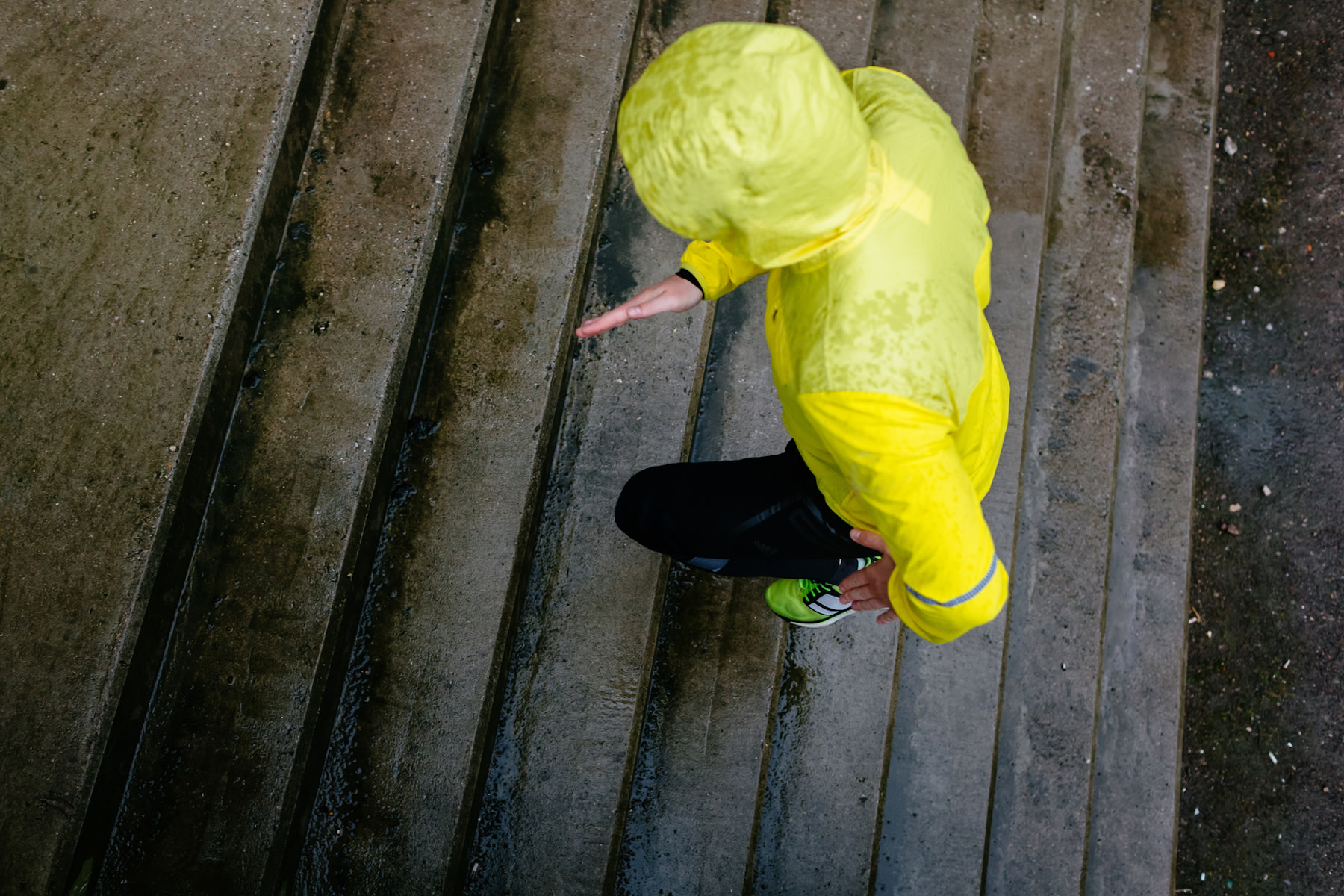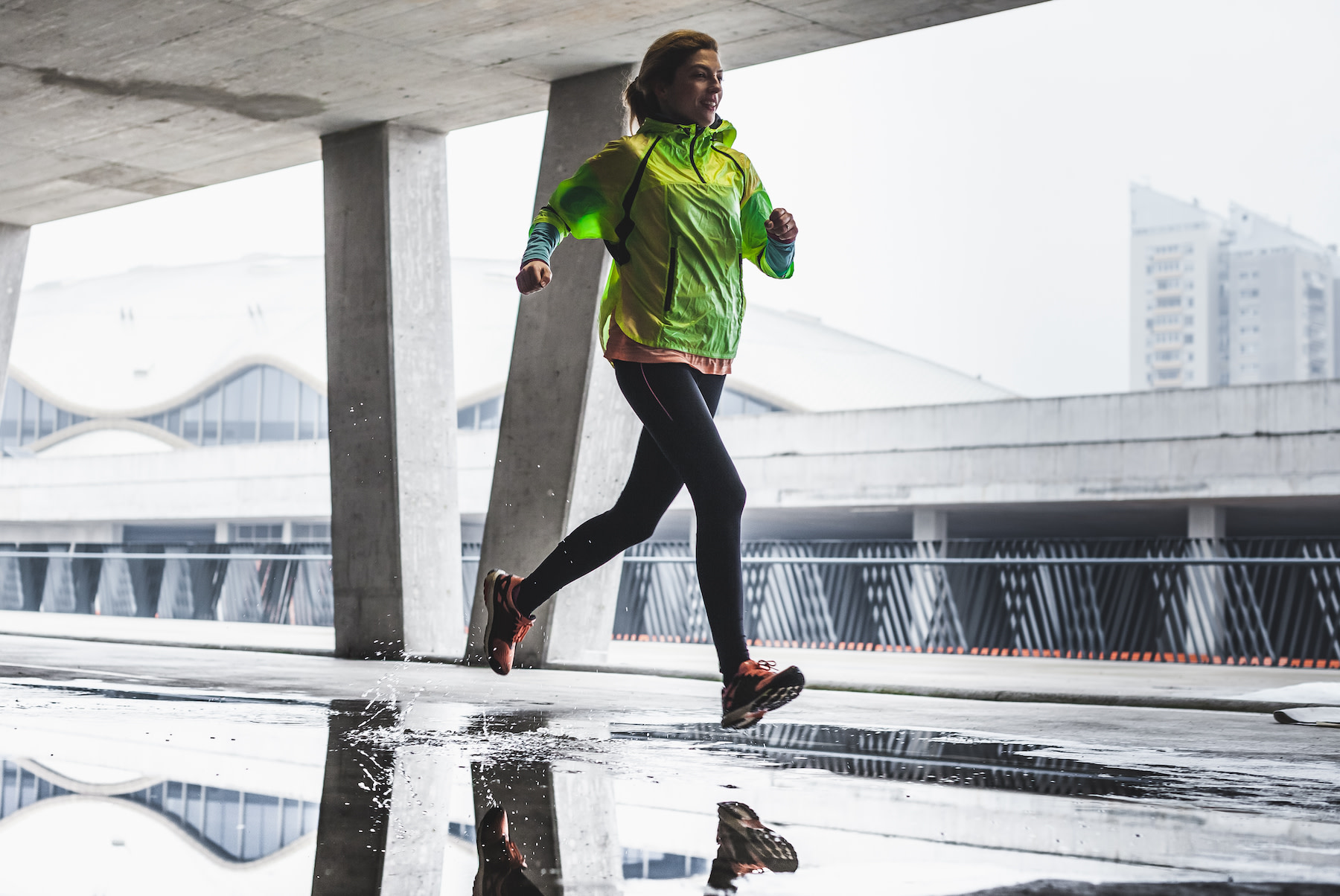
© minamoto images / Stocksy United
9 Expert-Backed Tips for How to Embrace Running in the Rain
Here's how to stay safe (and even have fun) during rainy-day jogs.
By Sara Lindberg•
Benefits of Running in the Rain
Is It Safe to Run in the Rain?
Tips for Running Safely in the Rain
Post-Run Care: How to Dry Off and Recover
When to Run Indoors Instead
The Takeaway
If gloomy weather has left you in a training rut, it might be time to consider a rainy-day run. While the steady stream of rain might pair better with a Netflix marathon than exercising outside, you may be surprised how many runners find running in the rain an enjoyable way to train. Plus, the benefits often outweigh the hassles, as long as you’re properly prepared for the elements.
Below, we chatted with the experts about why running in the rain can be beneficial, safety factors to consider, what to do after your workout, and some pro tips for making the most of the wet weather.
Benefits of Running in the Rain
Hard-core runners often train in any conditions, even pouring-down rain. But that (understandably) may not be the case for many of us. If getting soaked while pounding through the puddles is not high on your to-do list, consider these benefits of running in the rain:
It prepares you for a rainy race day. Organizers typically don’t cancel races because of rain, so whether you’re training for a 5K or a marathon, getting used to running in the rain can prepare you for potential inclement race-day weather, says Peloton instructor Selena Samuela.
It helps you connect with your surroundings. While it can be easy to zone out during a jog in standard weather conditions, running in the rain almost demands you to stay present and focus on your surroundings. Engaging in this sort of mindfulness during a workout can lower stress levels and promote overall mental well-being.
It builds resilience, confidence, and mental toughness. Running in adverse weather conditions like rain can build mental strength—it takes dedication to stick to your fitness routine despite bad weather, after all. What’s more, conquering a run in the rain can leave you with a serious sense of accomplishment.
It may quiet a normally crowded running route. Rain tends to keep people indoors, so you might find that your regular running route is less crowded.
It might even be fun. Running in the rain adds an element of spontaneity and newness to your exercise routine, which can make the experience genuinely joyful and, as Selena describes it, exhilarating.
Is It Safe to Run in the Rain?
Staying safe and preventing, or at least minimizing, potential injuries is key while running in the rain. Making time for proper warm-ups and cool-downs, maintaining good form, and knowing when to slow down can help keep you safe when the weather turns wet.
John Gallucci Jr., DPT, a physical therapist, athletic trainer, and CEO of JAG Physical Therapy, says running in the rain can be fun, but it also comes with some serious risks, such as fungal infections, blisters, or even more serious injuries like fractures. “Running in the rain can also cause body temperature to drop if [you’re] not dressed properly, which can lead to hypothermia,” he adds. And of course, there’s the danger of slips and falls when the ground is slippery or wet.
Results from one small study in 2019 also suggest that rain might hamper exercise performance and impact safety. The study’s results found that rain initially increased heat loss during the start of a workout, followed by increased heat production and temporarily suppressed cold stress. But as exercise continued and participants’ bodies became more wet, they lost more heat and used up more energy.
All of these potential risks are why it’s so important to listen to your body and properly prepare for running in the rain. (Read on for tips on how to do just that.)
Will Running in the Rain Make You Sick?
The old wives' tale that running in the rain will make you sick may be more myth than fact. That’s because colds and flu are caused by viruses, not by getting wet.
That said, while running in the rain won't directly lead to sickness, it can cause your body temperature to drop if you’re not dressed appropriately, as Gallucci explains above. Cold temperatures may weaken your immune system and leave you more at risk of illness, so bundle up, wear protective gear, and take preventative steps to stop the spread of germs (think: washing your hands and avoiding touching your eyes, nose, and mouth).

sanjeri / E+ via Getty Images
Tips for Running Safely in the Rain
While getting outdoors is definitely good for the soul, it’s essential to take safety precautions when running in the rain. Here are some expert tips to help you stay safe and make the most of exercising in wet conditions:
1. Choose Your Clothing Wisely
When thinking about what to wear when running in the rain, you should always choose function over fashion. Gallucci suggests using a water-resistant jacket and layering up. “This will help you stay warm and dry to help prevent medical issues such as hypothermia,” he explains.
Beyond the outer layers, opt for moisture-wicking clothing to prevent excessive soaking, as well as a brimmed, waterproof hat to shield your face from raindrops. Selena also recommends a waterproof vest or running jacket, which can help avoid total soaks.
2. Wear the Right Shoes
Wearing the right running kicks is always a top priority, but it’s even more important when the ground is wet. Wear shoes with good traction to prevent or minimize slipping, and consider investing in water-resistant or waterproof running shoes. “The type of footwear or running shoe can help prevent slips and falls, so make sure your shoes do not have a run-down outsole since that can decrease the amount of traction it has with the ground,” Gallucci says.
3. Take Time to Warm-Up
A good warm-up boosts blood flow, increases flexibility, and mentally switches you into runner mode. Aim for five to 15 minutes of movements that mimic running. For instance, a few minutes of light jogging or fast walking followed by a series of dynamic exercises like walking lunges, hip openers, leg swings, high knees, side lunges, and arm swings.
4. Adjust Your Stride and Pace
When you’re running in the rain, Gallucci recommends taking smaller steps to help increase your balance, like when you’re approaching turns or downhills. Be sure to slow down to reduce slips and falls, too.
5. Mind Your Surroundings
Being mindful of the exteriors and surfaces you’re running on is critical, Selena says. Stay aware of slippery areas, such as painted lines and metal grates. Avoid puddles if possible, as they might hide uneven surfaces. In addition to wet areas, Selena also recommends avoiding piles of leaves or trash that you could slip on.
6. Be Visible
Rain can make you less visible to drivers, bikers, or other pedestrians, so Gallucci always recommends wearing bright colors so that others can see you no matter where you’re jogging. You may also want to consider using a headlamp or other visibility gear if it's dark.
7. Stay Hydrated
Just because you're surrounded by rain doesn't mean you're hydrated. Sip water as you would during any other run and watch for signs of dehydration like feeling very thirsty, dry mouth, fatigue, dizziness, dark-colored urine, and urinating or sweating less than usual.
8. Protect Your Phone
Your smartphone likely costs more than your entire running wardrobe, so make sure to use a waterproof case or a plastic bag to protect your phone and any other electronic devices.
9. Skip the Headphones
Selena acknowledges that this tip might not be the most fun to follow, but if you’re running in the rain, leave your headphones at home. “It’s important to be fully aware of your surroundings, and you want to be able to hear if there’s thunder, a car coming, or any other hazard that is greater in the rain,” she explains.
Post-Run Care: How to Dry Off and Recover
Drying off and changing clothes are likely the first things to come to mind when thinking about post-run care, but there are a few other things to check off your recovery list before you call it a day. If you’re soaked, Selena recommends changing out of wet clothes right away and drying your gear to keep it in good shape and prevent any musty smells.
Speaking of drying off, you might want to pay special attention to your skin. Wet skin is prime for chafing, especially your inner thighs, groin, glutes, armpits, and under your breasts. Drying off will help you avoid feeling chilly and chafed. You may even want to swap out your wet gear before doing your post-run stretches.
Hydrate well, too—as mentioned above, running in the rain can lead to dehydration just as much as jogging in the sun. And if you have time, a warm shower can help regulate your body temperature and wash away any remaining feelings of chilliness. Not to mention, it's simply a nice way to relax and unwind post-run.
When to Run Indoors Instead
Even hard-core runners need to take their training indoors when the weather gets too wet or hazardous. Dangerous conditions like lightning, high winds, icy conditions, or hail signal that it’s time to head to the nearest treadmill or indoor environment to exercise instead. (There are plenty of Tread and other indoor-suited classes to enjoy on the Peloton App!)
“Safety should be your top priority, so if there are poor weather conditions, it’s best to stay indoors to run,” Gallucci says. Plus, running on a treadmill comes with countless benefits of its own, like the ability to track your pace and progress with more accurate technology.
The Takeaway
Whether rainy day runs are an occasional occurrence or part of your normal routine, planning ahead, wearing the right clothing, checking the forecast, and knowing your limits can keep you safe and allow you to have fun, all year long. Practice the proper post-run care, and make sure to stay indoors during dangerous conditions like lightning and high winds. When you come prepared and follow safety protocols, running in the rain can be a surprisingly amazing way to work out and connect with yourself and your surroundings.
This content is for informational and educational purposes only and does not constitute individualized advice. It is not intended to replace professional medical evaluation, diagnosis, or treatment. Seek the advice of your physician for questions you may have regarding your health or a medical condition. If you are having a medical emergency, call your physician or 911 immediately.
Level up your inbox.
Subscribe for a weekly dose of fitness, plus the latest promos, launches, and events.